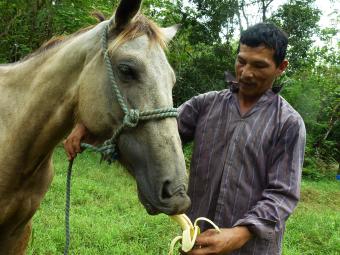The dynamic principle: a day on lo tuyo
The dynamic principle: a day on lo tuyo
Way before the sun rises there is a buzzing of activity: the mysterious sounds of the night – in this case, a frog – are followed by festively chirping birds. With the sun’s first rays the insects join in and stay all day long, and not just with their singing.
Work starts at 7:00AM. Those who spent the night in the stilt houses climb out of their hammocks; others come by bike or on horseback. Eda comes along holding one half of a wheelbarrow, sucking on a bright pink ice cream cone from thetiendita on the main street. Jose, a local rural worker, holds the other half of the wheelbarrow, his second hand also busy with ice cream. The two work many things together and many things work with the two of them: growing of crops and gardening all around the plots; this is their field.
Volunteers Flo and Jan from Germany, supported by William from the neighboring town, are busy working on the buildings. Even though William – just like almost all young workers from the countryside – does not have a complete work education, but he is clever and learns quickly. And, this is necessary because qualified volunteers like Jan (not only a carpenter, but plumber as well) are usually on site only for about three months. Only? Yes, only, because in the tropics the clock ticks somewhat differently. In particular, the time spent waiting for materials goes beyond the scope of what seems possible: “Mañana, for sure!” …is heard for two weeks now. But even the most hardened latino is not immune to Hanna’s insistent cell phone calls, which she always resolves calmly – or so it seems. And so it arrives after all, the truck from the chino in David, the provincial capital on the border with Costa Rica. It carries tubing, cement, corrugated metal sheets and sanitary accessories - materials for many construction sites. Currently, we are working on the second stilt house - the environmental education center – and on the MaMa, the marmalade processing plant. In addition, an old storehouse is being converted into the office building.
Where is Jan? …on another site; his know-how is needed everywhere. While the power was out he was at the town’s blacksmith, getting the chainsaw running. Jose is shooing the chickens out of the educational garden, Silke is standing – stunned – in front of one of her flower beds: overnight, the arrieras ants snipped every leaf off all of her bean plants to carry back to their nest in the jungle.
While the insects’ busyness peaks around midday, the glimmering tropical heat and air saturated with humidity slow down the humans. At 12:PM it’s lunchtime, all lo tuyos meet in the shade of the first stilt house. Stories are told in English, Spanish and German, including all varieties and mixtures of the languages. Butterflies swarm around flowerbeds, birds around fully ripe bananas hanging next to the pantry hoping for a bite. Sitting among the fruits is an azulejo, a pretty pure blue finch, picking at the sweet mash.
Early afternoon starts slowly; harvests are being fully dried, tanks filled (if the water is running), computer work is being done (if the internet is working), the work of the day is being observed and the next day’s prepared. Hanna is on her cell phone. The neighbors’ kids bring mangos; Jose shows off a grass-green iguana, which is admired and then set free again. We get a surprise visit from Anibal. He comes from the nearby comarca of the indigenous Ngöbe-Buglé Indians.
Work ends at 3:PM. Officially, a workday lasts only 7 hours In Las Lajas (aaahhhh!) but then, we work Saturdays (ooohhh!). This schedule leaves time for visiting Las Lajas’ stunning sandy beach, where some body board, others collect shells for dinner, and others still enjoy a fresh cool coconut in the shade.
As the sun falls into the sea, the insects wind down, the birds tune up, and the stage is set for the mysterious sounds of the night.



